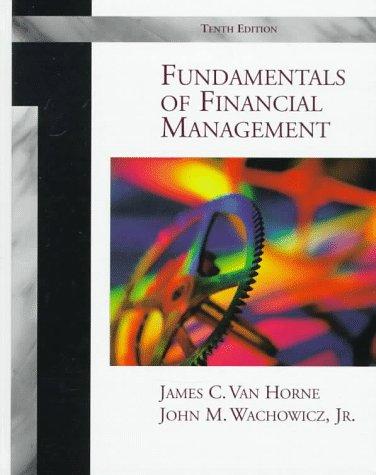Question
DISTRIBUTION POLICY Southeastern Steel Company (SSC) was formed 5 years ago to exploit a new continuous casting process. SSCs founders, Donald Brown and Margo Valencia,
DISTRIBUTION POLICY Southeastern Steel Company (SSC) was formed 5 years ago to exploit a new continuous casting process. SSCs founders, Donald Brown and Margo Valencia, had been employed in the research department of a major integrated-steel company, but when that company decided against using the new process (which Brown and Valencia had developed), they decided to strike out on their own. One advantage of the new process was that it required relatively little capital in comparison with the typical steel company, so Brown and Valencia have been able to avoid issuing new stock and thus own all of the shares. However, SSC has now reached the stage at which outside equity capital is necessary if the firm is to achieve its growth targets. Therefore, Brown and Valencia have decided to take the company public. Until now, Brown and Valencia have paid themselves reasonable salaries but routinely reinvested all after-tax earnings in the firm, so dividend policy has not been an issue. However, before talking with potential outside investors, they must decide on a dividend policy. Assume you were recently hired by Pierce Westerfield Carney (PWC), a national consulting firm that has been asked to help SSC prepare for its public offering. Martha Millon, the senior PWC consultant in your group, has asked you to make a presentation to Brown and Valencia in which you review the theory of dividend policy and discuss the following issues. a. (1) What is meant by the term distribution policy? How has the mix of dividend payouts and stock repurchases changed over time? (2) The terms irrelevance, dividend preference, or bird-in-the-hand, and tax effect have been used to describe three major theories regarding the way dividend payouts affect a firms value. Explain what these terms mean, and briefly describe each theory. (3) What do the three theories indicate regarding the actions management should take with respect to dividend payouts? (4) What results have empirical studies of the dividend theories produced? How does all this affect what we can tell managers about dividend payouts? b. Discuss (1) the information content, or signaling, hypothesis, (2) the clientele effect, and (3) their effects on distribution policy. c. (1) Assume that SSC has completed its IPO and has a $112.5 million capital budget planned for the coming year. You have determined that its present capital structure (80% equity and 20% debt) is optimal, and its net income is forecasted at $140 million. Use the residual distribution approach to determine SSCs total dollar distribution
Step by Step Solution
There are 3 Steps involved in it
Step: 1

Get Instant Access to Expert-Tailored Solutions
See step-by-step solutions with expert insights and AI powered tools for academic success
Step: 2

Step: 3

Ace Your Homework with AI
Get the answers you need in no time with our AI-driven, step-by-step assistance
Get Started


